Maybe it's an old family vacation tape, a blurry concert recording, or a clip you shot years ago on a phone that barely shot in HD. Whatever the case, we've all had videos that just don’t hold up by today’s standards. That’s why video enhancement tools have become increasingly popular—they offer a way to breathe clarity and detail back into footage that would otherwise be forgotten.
To help you decide which tool might be right for your needs, we’ve been reviewing a few of the most talked-about video enhancers out there. Today’s focus is on DVDFab Video Enhancer AI, a software that claims to use AI to upscale and improve video quality. In this review, we’ll cover DVDFab Video Enhancer’s core features, how easy it is to use, what kind of hardware it needs to run properly, and address some frequently asked questions.
UniFab Video Enhancer AI demands high-end NVIDIA RTX GPUs and can struggle on many standard computers, making it less accessible for casual users or those with mid-range hardware.
![]() To run smoothly on a wider range of systems: Try Aiarty Video Enhancer
To run smoothly on a wider range of systems: Try Aiarty Video Enhancer
Aiarty Video Enhancer supports AMD, Intel, and NVIDIA GPUs with just 4GB of VRAM, making it far more accessible. It delivers fast previews and high-quality results—even on mid-range machines. You can use it to upscale, denoise, sharpen, adjust colors, convert SDR to HDR, and boost frame rates in just a few clicks.
This YouTube video reviews Aiarty Video Enhancer. Watch it to see how Aiarty fixes low-quality footage.
Download Aiarty Video Enhancer to improve your video quality instantly:
What Happened to DVDFab Video Enhancer AI?
If you're trying to find DVDFab Video Enhancer AI on the official website and coming up empty-handed, you're not imagining things. DVDFab has since reorganized some of its products under a new platform called UniFab, which combines tools like video upscaling, denoising, and format conversion into one unified interface.
That said, the standalone DVDFab Video Enhancer AI is still functional if you already have it installed, and in some cases, it's available through alternative sources like the Microsoft Store. For this review, we’ll be focusing on the Upscaler and Denoise AI modules within UniFab, which inherit much of the functionality from the original DVDFab Video Enhancer AI.
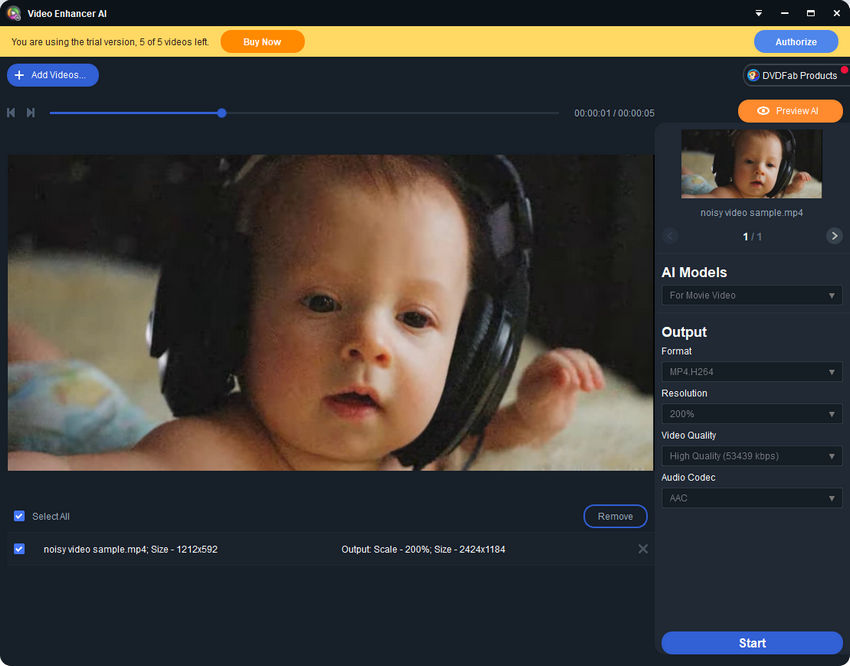
DVDFab/Unifab Video Enhancer AI Review
System Requirements
Before diving into the actual performance, it's important to look at what kind of hardware UniFab’s AI features demand—because let’s be clear, AI-driven video enhancement isn’t lightweight work.
To run UniFab’s AI Video Enhancer smoothly, the official recommendation is:
- OS: Windows 11 or Windows 10 (64-bit)
- RAM: At least 16GB (more is better)
- GPU: NVIDIA RTX 30 series or above, with a minimum of 8GB VRAM
While UniFab technically runs on lower-end systems, the AI enhancement tools—especially upscaling to 4K—require a powerful GPU to process video in a reasonable time. During testing, even on a system with an RTX 3060 and 32GB of RAM, some tasks like 1080p to 4K upscaling took several minutes for short clips. Older or non-NVIDIA GPUs may run into long wait times or even processing errors.
In short: if your system doesn’t meet these specs, don’t expect real-time previews or quick turnarounds.
Core Video Enhancement Features
So, what exactly can UniFab Video Enhancer AI do for your videos?
According to the developer, UniFab offers a range of AI-driven features aimed at improving video quality in different ways. Here's a quick rundown of what it claims to offer:
- Video Upscaler AI: Designed to increase resolution from SD to HD, 4K, or even 8K using AI-trained models. It’s meant to help recover lost detail and reduce compression artifacts in low-res footage.
- Denoise AI: Targets visual noise caused by low-light shooting or compression, with the goal of producing cleaner, smoother images.
- Stabilizer AI: Aims to reduce shakiness in handheld or action footage, making the video more stable and easier to watch.
- Smoother AI: Uses AI-based frame interpolation to make choppy footage look more fluid—supporting frame rates up to 120fps.
- Colorizer AI: Automatically adds color to black-and-white videos using scene recognition.
These are the main enhancement features currently highlighted by UniFab. In the next section, we’ll take a closer look at how easy it is to actually use these tools—and whether they live up to expectations.
Ease of Use & Workflow
Getting started with UniFab Video Enhancer AI is fairly straightforward—at least on the surface. Once you launch the program, you’ll find the AI tools like Upscaler and Denoiser located under the “Video AI” section. From there, you select the feature you want, and the software takes you into a dedicated workspace.
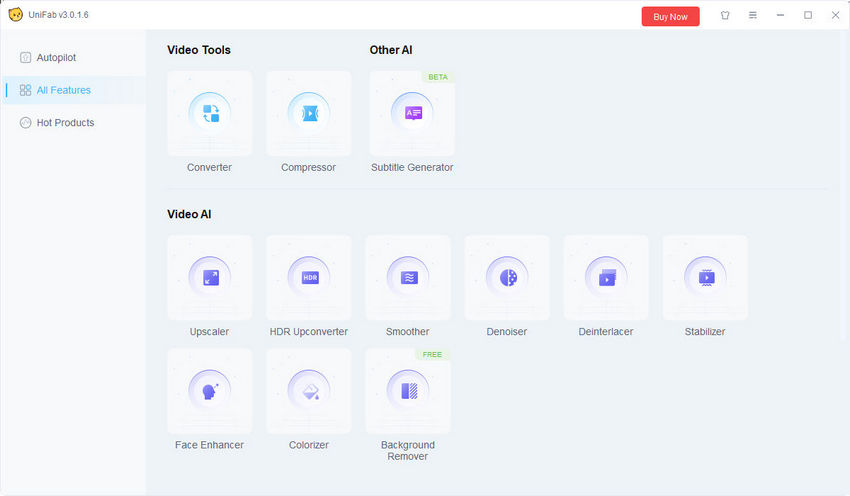
The interface is clean and intuitive: you import your video, set your desired resolution and format, choose codec and quality settings, and pick an output folder. There are also options to crop or preview your video before hitting Start.
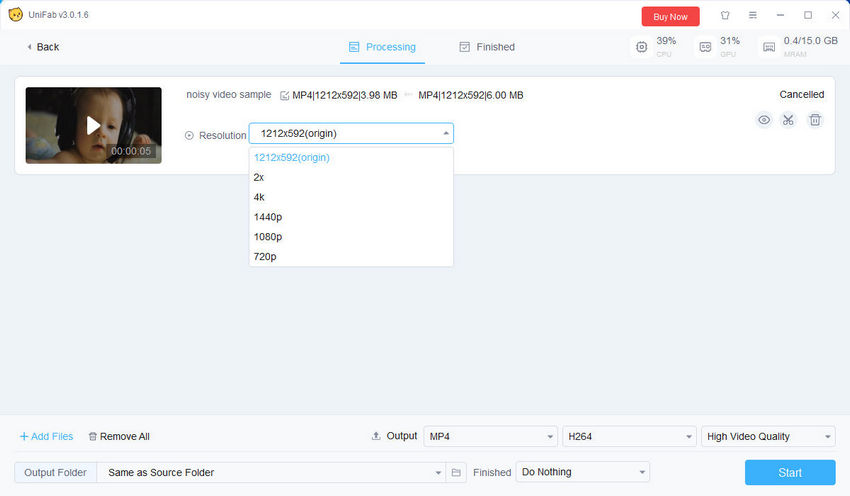
That’s the theory.
In practice, I ran into issues almost immediately. The preview never loaded, and after a few clicks, the software would frequently freeze and become unresponsive. Despite having a high-end CPU and plenty of RAM, my system lacked the recommended RTX GPU—and that seemed to be a dealbreaker. Without it, the AI modules simply couldn’t run smoothly, or at all.
For a tool that's marketed as easy to use, this was frustrating. While the UI looks polished, it quickly became clear that UniFab is only truly usable on very specific hardware setups.
Testing Environment: Why It (Probably) Didn’t Work
To give UniFab a fair shot, I tested it on two different Windows machines:
- PC A: Intel i5-4460, 16GB RAM, no discrete GPU
- PC B: Intel i7-13700K, 32GB RAM, integrated graphics only (no RTX card)
Despite the second setup having a modern CPU and plenty of memory, neither system could handle UniFab’s AI tools properly. The software technically opened, but once I tried to preview or process anything, it either froze or completely stopped responding.
This aligns with what the official documentation says: UniFab’s AI modules—especially video upscaling—rely heavily on a powerful NVIDIA RTX GPU with at least 8GB of VRAM. Without one, you're likely to run into constant lag, crashes, or total failure to process.
For casual users who just want to enhance a few videos on a standard computer, that’s a serious limitation. It’s also something you might not realize until you’ve already installed and started using the software.
UniFab Pros and Cons
- Intuitive and easy-to-navigate interface
- Supports a wide range of popular video formats
- Advanced AI upscaling and enhancement features (on compatible hardware)
- Demands a high-end NVIDIA RTX GPU with at least 8GB VRAM for stable operation
- Likely to freeze, crash, or fail on systems without a supported GPU
- Not well-suited for casual users or those with mid-range hardware
Looking for a Better Alternative to DVDFab/Unifab Video Enhancer AI?
If UniFab didn’t meet your expectations — whether due to hardware incompatibility or underwhelming results — you're not alone. Some users may find that even with the right GPU, UniFab’s output lacks sharpness, introduces artifacts, or struggles with heavily compressed or older footage. And if your system doesn't meet the strict requirements, the software is practically unusable.
This is where Aiarty Video Enhancer steps in as a strong alternative.
Unlike UniFab, Aiarty is designed to support a broader range of hardware configurations while still delivering high-quality video enhancement results.
Aiarty’s AI models are trained to handle real-world imperfections, helping increasing video resolution, recover lost detail, fix motion blur, reduce compression noise, and remove grains — all with minimal setup.
Hands-On with Aiarty Video Enhancer
Aiarty isn’t just about broader hardware compatibility—it also delivers a refined and efficient user experience. From installation to export, the workflow is streamlined for both beginners and more experienced users looking to enhance large batches of footage.
Step 1: Simple Setup and Import
After downloading and installing Aiarty Video Enhancer, getting started is easy. Launch the program and click the + button to import your video file(s). Drag-and-drop is supported as well, which comes in handy if you’re working with multiple clips. Aiarty fully supports batch processing, allowing you to enhance several videos in one go without reconfiguring settings repeatedly.
Step 2: Choose an AI Model Tailored to Your Footage
Aiarty provides several AI models, each trained for different types of video content and enhancement goals:
- moDetail-HQ v3 – A precision model combining Diffusion and GAN techniques to sharpen and clean up high-detail footage such as nature scenes, hair, or outdoor environments. Available in 1×, 2×, and 4× upscaling.
- Smooth-HQ v3 – Optimized for human faces, indoor scenes, and softly lit footage, producing more natural, smooth results.
- superVideo vHQ – A high-performance model designed to enhance very dark or noisy video, such as night scenes and low-light recordings.
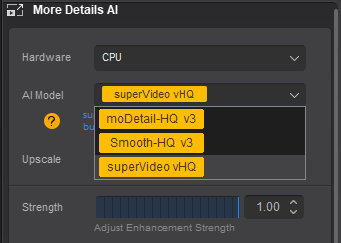
Choosing the right model depends on your source video. But Aiarty makes switching models quick and easy, so experimentation is encouraged.
Step 3: Set the Output Resolution
You can either select a scale factor (2× or 4×) or specify a target resolution like 3840×2160 (4K). This flexibility is useful whether you're restoring old 480p home videos or cleaning up 1080p footage for display on a larger screen.
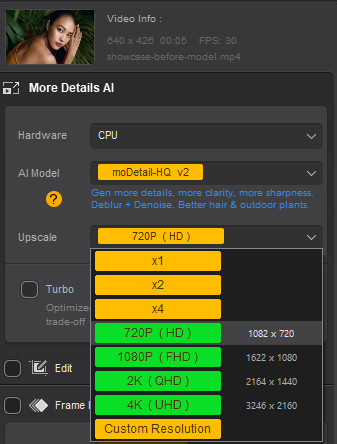
Step 4: Preview Before You Commit
Aiarty allows you to preview your video with the selected model before running a full export. After clicking Preview, the software briefly loads the model and begins inference—typically within a few seconds. Thanks to efficient GPU utilization, the preview process feels quick and responsive even on mid-tier systems.
This preview step is especially helpful when fine-tuning your results. If you’re not satisfied, simply try another model, enable Step Mode, adjust the Strength or other settings, and then compare the difference.
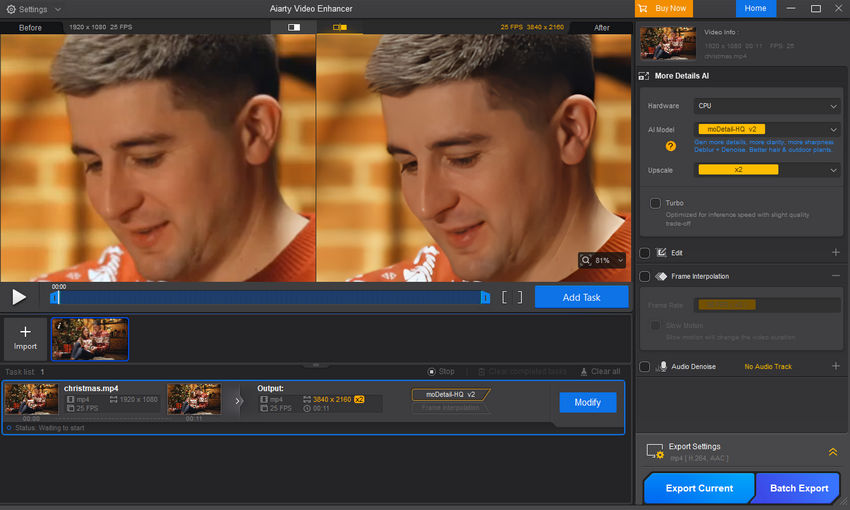
Step 5: Add to Queue and Export
Once you’re happy with the enhancement, click Add Task to queue the video. Aiarty supports both single and batch exports:
- Use Export Current for one video
- Use Batch Export to process multiple clips in one go
Aiarty doesn’t just upscale — it restores. In sample comparisons, fine texture and natural sharpness are visibly improved. Details lost in the original—such as soft hair strands or subtle edges—are reconstructed with impressive realism.
UniFab vs. Aiarty: Which Video Enhancer Is Right for You?
 FAQs
FAQs
UniFab Video Enhancer AI is not free. It offers a 30-day free trial. After the trial ends, a paid license is required to continue using the software.
Yes, UniFab is developed by DVDFab, a well-established software company. The installer is digitally signed and does not contain malware or bundled third-party software. Be sure to download it from the official website to avoid fake versions.
The software itself may install and run, but the AI enhancement features require a powerful NVIDIA RTX GPU (8GB VRAM or more). Without this, features like preview and export may freeze or fail entirely.
Yes, UniFab offers a preview option. However, on unsupported or underpowered systems, the preview often fails to load or causes the software to become unresponsive.
DVDFab Video Enhancer AI was the original standalone tool. UniFab is the newer platform integrating multiple AI modules (upscaling, denoising, format conversion) into one interface. UniFab is actively updated while the old version has been deprecated.
The interface is user-friendly, but the software’s performance heavily depends on having a powerful PC. Beginners without a supported GPU may find the tool frustrating or unusable.